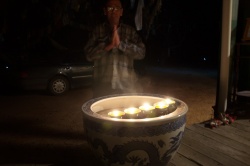Difference between revisions of "Paramattha Dhammaa"
Jump to navigation
Jump to search
| Line 15: | Line 15: | ||
[[Citta]], [[cetasika]] and [[rupa]] are [[sankhara dhammas]], [[conditioned dhammas]]; they do not arise by themselves, each of them is [[conditioned]] by other [[phenomena]]. | [[Citta]], [[cetasika]] and [[rupa]] are [[sankhara dhammas]], [[conditioned dhammas]]; they do not arise by themselves, each of them is [[conditioned]] by other [[phenomena]]. | ||
| − | [[Nibbana]] is the [[unconditioned | + | [[Nibbana]] is the [[unconditioned dhamma]], [[visankhara dhamma]] or [[asankhata dhamma]]; it does not arise and fall away. |
</poem> | </poem> | ||
{{R}} | {{R}} | ||
[http://www.wisdomlib.org/definition/paramattha-dhamma/index.html www.wisdomlib.org] | [http://www.wisdomlib.org/definition/paramattha-dhamma/index.html www.wisdomlib.org] | ||
[[Category:Abhidharma]] | [[Category:Abhidharma]] | ||
Latest revision as of 11:07, 21 December 2016
Paramattha Dhamma or Abhidhamma is not a Dhamma which is beyond one"s ability to understand because paramattha Dhamma is reality. Right view, right understanding, is actually knowing the characteristics of paramattha Dhammas as they really are.
There are four paramattha dhammas:
citta
cetasika
rupa
nibbana
Citta, cetasika and rupa are sankhara dhammas, conditioned dhammas; they do not arise by themselves, each of them is conditioned by other phenomena.
Nibbana is the unconditioned dhamma, visankhara dhamma or asankhata dhamma; it does not arise and fall away.
